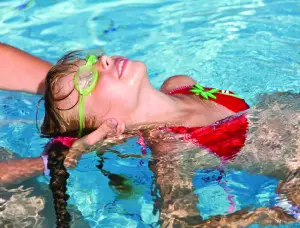 An estimated five to 10 million infants and preschoolers participate in formal aquatic instruction programs throughout the United States. Programs for the littlest water bugs focus on getting them comfortable in the water as well as helping parents become aware of basic safety measures (for instance, whenever infants or toddlers are in or around water, an adult should be within arm’s reach, providing “touch supervision”). But when your child hits the age of four, he is developmentally ready to undergo formal swimming lessons. And every child should learn how to swim to reduce the risk of drowning.
An estimated five to 10 million infants and preschoolers participate in formal aquatic instruction programs throughout the United States. Programs for the littlest water bugs focus on getting them comfortable in the water as well as helping parents become aware of basic safety measures (for instance, whenever infants or toddlers are in or around water, an adult should be within arm’s reach, providing “touch supervision”). But when your child hits the age of four, he is developmentally ready to undergo formal swimming lessons. And every child should learn how to swim to reduce the risk of drowning.
“The best approach is to make everything about water fun and positive,” says Caroline Kaczor, aquatics and health director at Sportime NY. “Take baby steps,” she suggests. “At bath time, start small by getting your child to pour cups of water on his or her head. Let your child lead the operation depending on her comfort level.”
But what if your son or daughter isn’t so eager to get wet? Whether due to fear of the water or a simple aversion to feeling cold, some youngsters just don’t want to get in the pool to learn. Remember that, as Kaczor reiterates, “It’s best not to force anything if the child is fearful.” But there are always measures parents can take to ease their child’s transition from non-swimmer to willing participant. To help you, we asked local experts – including summer camp owners and aquatics directors – for their advice.
Ask the Experts:
How can I encourage my child to learn how to swim if she is completely uninterested or afraid?
“The most effective way to encourage a child who is scared is to begin to speak about what will happen before even getting close to the water. Parents should talk about the fun that they had learning to swim, and how they look forward to going in the pool with their children. Whenever possible, get right into the pool with your kids; that goes a very long way toward making them comfortable with their surroundings.
If you plan on giving them swim lessons, remember to look for a program that meets your needs-one with qualified water safety instructors (preferably Red Cross WSI certified), and one that allows you as the parent to be present for the lessons, especially for the first few if your child has fear. And always be positive and encouraging no matter how the child is progressing!”
-Jack Grosbard, owner, Mill Basin Day Camp
“Not building a fear of the water is important. Always start off slow, putting the child on the deck of the pool with his or her feet in the water. Be patient, as it can take a few weeks to ease them into the water. Once they become comfortable with their surroundings, then children’s fear of the water tends to go away. Never push or force a child into the water; that will just create a bad experience that will be remembered forever.”
-Howard Seidman, camp director (and former aquatics instructor), Hillcrest Jewish Center Day Camp, Fresh Meadows
“Establish pool safety rules such as: only enter the pool if an adult is watching; and, no running around the pool area. Don’t focus on what can happen if the rules are broken, but be clear that the rules must be followed.
Trust is extremely important. If you say that you’ll be there to catch your child, show him continually that you will catch him when he says he needs you. Show your child how much fun you have while swimming in the pool as he watches from the side. This may make him want to join you.
Most of the children I’ve worked with who were fearful or uncomfortable about swimming began to enjoy the pool experience while sitting on the first couple of steps. Let children play with underwater dive toys in the shallow water from the safety of the steps, where they feel comfortable and in control of the situation. When you’re little, that pool can look extremely daunting! Practice kicking, putting her face in the water (even if it’s just a little bit at a time) and reaching underwater for toys. The more at ease the child is near the water, the more likely she will have the desire to learn how to swim.”
-Caroline Kaczor, aquatics and health director, Sportime NY, with locations on Randall’s Island, in Westchester, and throughout Long Island
Also see more advice from experts in your area.






















